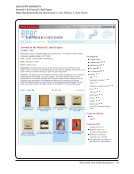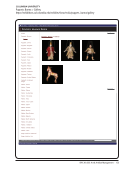114 · Representative Documents: Arrangement Guidelines
Washington University in St. Louis
Modern Graphic History Library Processing Manual
4
Order out of chaos. The initial survey of a collection may not show any order, but check closely as some
creators have a scheme that is not easily discernable.
Accessibility. The arrangement and description of a collection so that researchers can find information
with a minimum amount of searching. Accessibility may conflict with original order, so the decision about
arrangement must be decided on a case-‐by-‐case basis.
Lack of universality. There is no one way to arrange and describe all collections.
Service. One of the major goals of the Modern Graphic History Library is to make the material that has been
donated available and accessible to researchers. This is accomplished through the processing of
collections, as described in this manual by staffing a reading room with regular hours of operation by
responding to telephone, e-‐mail and written requests for information and by advising patrons on research
strategies.
Preservation. To preserve historical documentation is considered by many archivists to be the major goal
of the archival profession.
Informed judgment and common sense.
Types of Collections
Organic.
• Personal papers of an individual or family.
• Records of an organization.
Collective.
• Combination of organizational records and personal papers (as in the case of company records
that include the personal papers of the founder or executives).
Artificial.
• Discrete items assembled by a collector or by the Archives to document a particular person or
subject (e.g. Craver Collection).
**Each type could be a new collection or an accrual (addition to an existing collection). For accruals,
make sure to look at the original collection and discuss with the supervisor whether to integrate the
material or set up a similar separate arrangement.
Washington University in St. Louis
Modern Graphic History Library Processing Manual
4
Order out of chaos. The initial survey of a collection may not show any order, but check closely as some
creators have a scheme that is not easily discernable.
Accessibility. The arrangement and description of a collection so that researchers can find information
with a minimum amount of searching. Accessibility may conflict with original order, so the decision about
arrangement must be decided on a case-‐by-‐case basis.
Lack of universality. There is no one way to arrange and describe all collections.
Service. One of the major goals of the Modern Graphic History Library is to make the material that has been
donated available and accessible to researchers. This is accomplished through the processing of
collections, as described in this manual by staffing a reading room with regular hours of operation by
responding to telephone, e-‐mail and written requests for information and by advising patrons on research
strategies.
Preservation. To preserve historical documentation is considered by many archivists to be the major goal
of the archival profession.
Informed judgment and common sense.
Types of Collections
Organic.
• Personal papers of an individual or family.
• Records of an organization.
Collective.
• Combination of organizational records and personal papers (as in the case of company records
that include the personal papers of the founder or executives).
Artificial.
• Discrete items assembled by a collector or by the Archives to document a particular person or
subject (e.g. Craver Collection).
**Each type could be a new collection or an accrual (addition to an existing collection). For accruals,
make sure to look at the original collection and discuss with the supervisor whether to integrate the
material or set up a similar separate arrangement.


















































































































































































